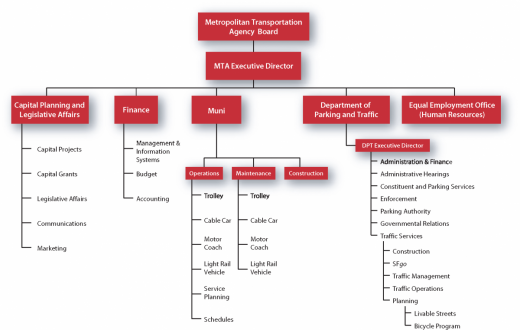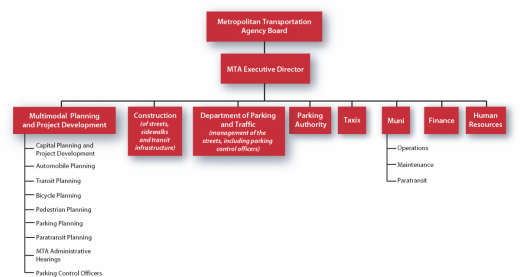The Muni reform effort that culminated in the passage of Proposition E in 1999 remains an incomplete project. While many things have improved, in particular Muni’s core operation of providing public transit service, many problems remain. The underlying goal of creating a truly integrated transportation agency that plans for improvements to all modes of transportation has not been achieved. This paper recommends a set of organizational changes, internal to the Municipal Transportation Agency (MTA), that would help us take the next step in transportation reform. It also identifies the broader, interagency transportation issues that create the context in which the MTA functions, and which require the cooperation of the MTA with other public agencies to achieve needed reforms.
Background and Context
In 1999, San Francisco voters approved Proposition E, which combined the Municipal Railway (Muni) and the Department of Parking and Traffic (DPT) into a new agency, the MTA. Among the many hoped-for benefits of the merger was the prospect of better management of the city’s streets, in keeping with a strengthened “Transit First” policy, which would both improve Muni service and make the streets friendlier to pedestrians and bicyclists.
In the five years since Prop. E’s passage, the city’s transit has gotten dramatically better. Basic Muni service began to improve early under the effective leadership of Muni’s general manager (and later MTA executive director) Michael Burns. His experience and expertise in transit operations reestablished professional competency in the basic operational tasks of labor deployment, vehicle procurement, fleet maintenance, staff training, and fiscal management after the nadir of the early- and mid-1990s. The economic boom of the late 1990s, together with the greater budget stability provided by Prop. E and funding from the City’s transportation sales tax, allowed for the restoration of Muni staffing levels and replacement of the aged Muni vehicle fleet.
But much remains to be done. The economic boom of the 1990s brought challenges as well as opportunities. The decade saw a big increase in auto congestion resulting from overall growth in employment, significant job growth outside the transit-rich downtown core, abandonment of planning policies that discouraged new parking in downtown offices, and a more affluent and auto-oriented population. As Muni became less reliable during the 1990s, many San Franciscans shifted to driving; late 1990s surveys of cars parked in the lots under Interstate 80 between the Bay Bridge and Central Freeway revealed that nearly half of the cars parked there belonged to commuters from the western part of the city.
Because every Muni line operates in mixed traffic, Muni service is particularly vulnerable to delays from traffic congestion. The negative consequences of Muni delays cannot be overstated. People make travel decisions based in part upon travel time. When faced with a choice between travel modes, most people will choose the faster mode even if it is more expensive because of the value they place on their time. As Muni service slows, service frequency decreases because it takes longer for a vehicle to make its route’s round trip. As this cycle turns and more people shift from transit to cars, the net result is a loss in person capacity of the overall transportation network. That is, the more people drive, the fewer people the streets can accommodate. Not only does our quality of life and our environment suffer, but these trends endanger the future economic health of the City as well.
So even as Muni made significant progress in providing reliable basic transit service, in the last few years the transportation situation of the 1990s has devolved into a vicious circle where slow and unreliable Muni service encouraged more driving, which increased traffic congestion, which in turn made Muni slower and less reliable, which further discouraged ridership.
The last decade also saw frustratingly little improvement in conditions for cyclists and pedestrians in San Francisco. The quality of the city’s sidewalks—the most extensive and frequently used public space in any city—varies but is overall rather poor. The number of traffic accidents where pedestrians and bicyclists are hurt or killed is alarmingly high. In the year 2000 alone there were 30 pedestrian fatalities reported by the California Highway Patrol. The city’s bicycle network, while much improved due to effective advocacy, is not contiguous, has significant gaps, and the enforcement of traffic violations in existing bike lanes is lax.
The experience of other cities over the past decade has shown that it is possible for affluent, auto-oriented cities to reinvent the way they design and manage streets, to both prioritize public transit and greatly increase the safety and amenity of city streets for pedestrians and bicycles. Barcelona, Chicago, Oxford, Paris, Portland, and Zurich have created handsome streetscapes that combine transit-priority street networks with bicycle and pedestrian enhancements. Cities like Los Angeles and Sacramento have adopted transit-priority measures—like traffic-signal prioritization—for entire transit corridors to improve transit speed and reliability. Considering the City’s already extensive transit network, and strong transit-first policies in both Prop. E and the General Plan, why has San Francisco been so timid?
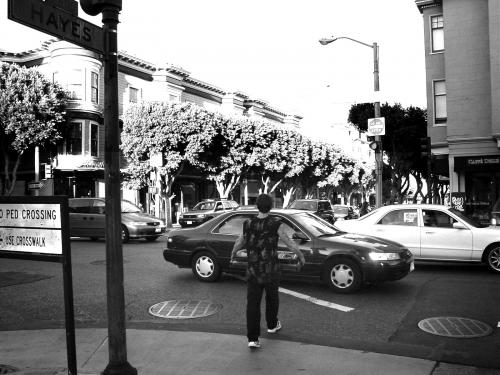
Many intersections in otherwise pedestrian-friendly neighborhoods, like this one at Hayes and Gough in Hayes Valley, have had crosswalks removed in order to facilitate car traffic.
Proposition E created a procedural and funding framework that allowed Muni’s new management to renew Muni operations and maintenance, creating the necessary preconditions for frequent and reliable transit service. 2004’s Proposition K, which renewed San Francisco’s transportation sales tax, provides greatly expanded funding for transit-priority improvements, bicycle and pedestrian programs, and streetscape improvements. In order to fulfill the full potential of Proposition E and Proposition K and create a high-quality transportation system and network of streetscapes for San Francisco, further reform is needed. This paper proposes a set of reforms to the MTA that will create a true multimodal planning function within the organization, capable of better integrating the needs of all transportation modes under the MTA’s responsibility.
Why Do We Need Multimodal Planning?
American cities like Portland and Chicago stand out as cities that have created attractive streetscapes that allow for safe, efficient movement of bicycles, pedestrians, and public transit as well as automobiles. Zurich, Barcelona, and Bogota stand out as international examples, and cities like Seattle, Paris, London, and Madrid are making efforts to catch up. San Francisco, however, despite its often urbane and environmentally minded reputation, its dense, pre-automobile urban fabric, and extensive transit system, continues to lag behind these cities in creating great streetscapes. Good multimodal planning is one of the critical missing pieces if we are to make a more livable city. Some of the problems with the current system include:
- The goal of turning the MTA into an integrated, multimodal transportation agency has not yet been realized. Despite the creation of some new MTA-level functions, the MTA is still effectively divided into Muni and DPT halves, which prioritize Muni vehicles or cars, respectively, with bicycle and pedestrian planning taking a back seat. No one is responsible for coordinating commercial and private-transportation needs, and no one is balancing the needs of each mode against the others in our limited public rights of way.
- The city’s street network is still treated essentially as infrastructure to facilitate as much car traffic as possible—what planners often call “traffic sewers.” Where cities all over the world are reclaiming streets for their original dual function, as both infrastructure to facilitate mobility and public space for city dwellers to spend time in, San Francisco remains mired in suburban, auto-oriented street design practices—from the suburban street designations such as “arterial” and “collector” to physical design standards that encourage excessive speeds—that are ill-fitted to our urban character. The only performance measure for judging the success of our streets is Auto Level of Service—the amount of delay vehicles experience. Other cities have shifted to person-delay measures, level of service measures for other modes, as well as “Quality of Service” measures as experienced by the users of all modes of transportation. Still other cities formally consider the function of streets in supporting neighborhood retail, public enjoyment, and other services.
- San Francisco’s street network is poorly planned, designed, and maintained. Basic pedestrian amenities and safety features, like wide sidewalks, pedestrian-level lighting, street trees, and prominently marked crosswalks, are the exception rather than the rule. Market Street is a good example of how difficult San Francisco has found it to design a functional multimodal street. It is the city’s main transit and bicycle route, and has been the subject of many official design and planning efforts, but the City has yet to create a continuous bicycle lane or to establish effective transit-priority measures.
- Muni vehicles operating on city streets remain chronically stuck in traffic, so that while service reliability has improved dramatically since 1999, overall trip time has not. The MTA has not managed to implement basic transit preferential streets improvements—signal preemption, bus bulb-outs, or transit-only lanes, for example—in any systematic way. While the MTA has redeployed parking control officers to major transit routes, it has not yet taken responsibility for the physical design of the streets.
- Large capital projects undertaken by MTA, most notably the Third Street Light Rail project and the Metro East facility, failed to integrate bicycle and pedestrian safety and amenities in their design; in fact, the Third Street Light Rail project will worsen conditions for pedestrians and cyclists on Third Street, which serves as both the main street for an anticipated new residential neighborhood and as an important north-south bike route.
MTA’s Current Structure
Despite the intent of creating a balanced multimodal transportation agency contained in Proposition E, the non-administrative functions of the MTA today are structured into two major modal divisions, one for transit (Muni) and one for cars (DPT). Other transportation modes that should be part of the core purpose of the agency—creating a comprehensive and safe bicycle network, protecting and enhancing the quality of the pedestrian realm across the city, and all innovations in street design that sometimes go under the name of “traffic calming”—are lodged in tiny, less powerful sub-departments within a larger DPT organization dominated by the traffic-engineering orthodoxy of maximizing vehicle throughput.
Planning functions are scattered throughout the agency—in MTA Capital Planning and Legislative Affairs, in Muni Service Planning, in DPT Administrative Hearings, and in DPT Traffic Services—with no responsibility for integrating planning among modes. The Bicycle and Livable Streets programs are buried in the Traffic Services division of DPT.
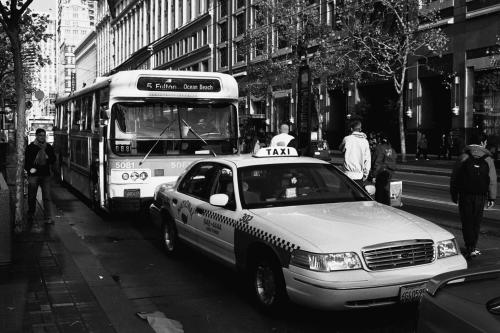
Along Market Street, the heaviest-transit-use street west of the Mississippi River, transit islands create a bottleneck that must be shared by buses, cars, taxis, and bikes, with pedestrians dodging all to get on the island.
Other functions are also duplicated in the current structure; both Muni and DPT maintain separate construction divisions, and DPT has its own Governmental Relations division in addition to the MTA-level division.
A Proposal for Change
We propose that MTA create an integrated transportation planning function charged with balancing all modes—pedestrians, transit, bicycles, private cars, delivery vehicles, taxis, and paratransit. This integrated planning function would also be responsible for planning and designing the transportation system that complements the City’s land use planning, both by managing the transportation demands generated by land use patterns, and by the design of individual streets that support the adjacent land uses.
This proposed organizational structure should provide both greater efficiency, by eliminating duplicate functions scattered throughout the agency, and greater effectiveness by focusing individual departments within the MTA on a defined set of complementary activities. Some of the specific benefits of this proposal include:
- Creating a Multimodal Planning and Project Development Department, which reports directly to the MTA executive director, will help integrate the presently disconnected planning functions within MTA, and give multimodal planning a higher profile within the agency. A strong, integrated, and focused MTA planning department is essential to successfully implementing the integrated multimodal transportation system envisioned by the Proposition K transportation sales tax program passed in November 2003
- Placing the planners for specific transportation modes within a single department with an integrative, multimodal focus will encourage planners to understand and manage trade-offs between various transportation modes, and will help planners understand individual transportation projects in a multimodal context
- Putting planning and project development together puts planners and urban designers in the role of designing streets and transportation facilities that integrate multiple users and functions, and affords engineers the more appropriate role of providing technical expertise in developing detailed project designs that address planning as well as engineering imperatives
- Creating a Parking Planning function within the new Multimodal Planning and Project Development Department will allow the MTA to create effective parking management plans at a neighborhood scale, replacing the current practice of ad-hoc, street-by-street parking management
- Consolidating separate Muni and DPT construction activities in an MTA-level construction department should allow for more efficient deployment of staff resources, better coordination of construction activities, and a wider pool of expertise in construction-related matters. As mentioned in the next section, some MTA street construction and maintenance activities may be better performed by the Department of Public Works (DPW)
- By consolidating MTA planning and construction activities in newly integrated departments, Muni and DPT can become more focused and manageable, allowing Muni to concentrate on core operations and maintenance activities, and DPT to concentrate on effective management of the city’s streets.
The proposed reorganization outlined here is entirely within the MTA, and can be implemented by the MTA board and executive director, without changes to the City Charter or to any other department.
While a reorganization of the MTA along these lines could do much to facilitate better planning at MTA, this proposed reorganization alone by no means ensures that truly integrated, multimodal planning will take hold in San Francisco. In order for this reorganization to be truly successful, three things must happen. First, the MTA executive director will need to take great care in selecting the new manager of the multimodal planning department. The new manager will need the vision, experience, and authority to develop new planning practices and standards for the city, and to orient the formerly separate planning groups toward a truly multimodal planning approach. Second, the walls between the formerly separate planning functions—traffic, pedestrian, bicycle, and transit—must be broken down internally, rather than remain separate islands of isolated practice within the new department. Finally, in order to create truly effective multimodal planning, the MTA will need to coordinate its planning activities with those of other agencies, including the San Francisco County Transportation Authority, the Planning Department, the Department of Public Works, and regional transit operators like BART, Caltrain, and AC Transit. Coordination between the MTA and other agencies is the focus of the next section.
Coordination With Other Transportation Agencies
The MTA, however, is only one of several major agencies responsible for the city’s transportation system. Other agencies plan, fund, or manage important pieces of the city’s transportation network.
The Planning Department makes land use decisions that have enormous transportation implications, creates a General Plan for the city that includes transportation and urban design elements, and manages environmental review. The department has historically taken a role in urban design of streets, although presently that role is much diminished.
The San Francisco County Transportation Authority is the chief conduit of transportation funding, and plays an increasing role in transportation planning and delivering capital projects. The Transportation Authority created San Francisco’s first Countywide Transportation Plan, is planning the Van Ness Bus Rapid Transit Corridor, and has been involved in the design, finance, and implementation of Octavia Boulevard and the Doyle Drive replacement.
The Department of Public Works is the chief agency responsible for construction and maintenance of the city’s streets and rights-of-way, although other agencies (including DPT and the Public Utilities Commission) share portions of that responsibility.
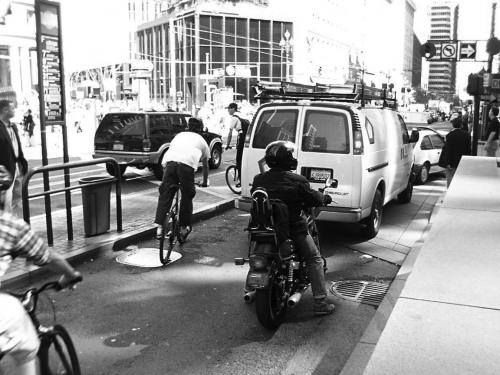
Counts by the San Francisco County Transportation Authority have shown as many as 7,000 pedestrians an hour at certain Market Street intersections, where they meet cars, buses, vans, bikes, and motorcycles.
Other City agencies involved in transportation include the Taxi Commission, the Police and Fire departments, and the Port of San Francisco. Regional and state agencies, including BART, Caltrain, SamTrans, Golden Gate Transit, the MTA, and Caltrans fill out the picture. The reforms of MTA recommended in this paper only begin a series of necessary reforms to the governance of San Francisco’s transportation system; in order to realize the vision of an integrated multimodal transportation system envisioned in Proposition E, and to realize the full benefit of the transportation programs funded in Proposition K, the City will need to undertake other needed reforms, including:
- Strategic transportation planning. Elements of citywide strategic transportation planning arecurrently the purview of three different agencies: the Transportation Authority administers regional, state, and federal transportation funds, administers the Proposition K transportation sales tax funds, and has prepared a Countywide Transportation Plan; the Planning Department authors the City’s General Plan and its transportation element, does environmental review, and makes land-use decisions with transportation implications; the MTA creates ten-year planning documents, a capital improvement plan, has created bicycle and pedestrian master plans, and recently created a “Vision Plan” for rapid transit expansion. More planning is being done, but to date, there is no shared vision for a desired transportation future for the city, no interagency strategy for getting there, and no integrated transportation planning at the highest level that encompasses revenue sources, capital projects, land use, and policy choices. One of the most obvious solutions—to have multiple agencies develop joint plans that are adopted by each of their commissions—has never even been tried.
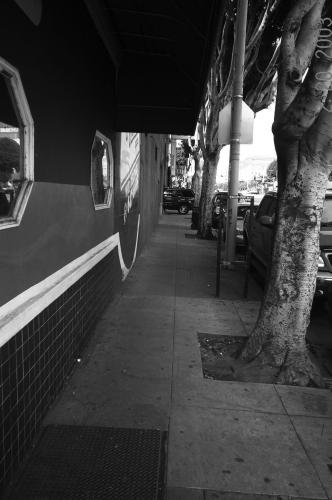
A narrow sidewalk in the Mission's southeast corner. Blank, narrow sidewalks like these detract from the walkability of the neighborhood and can lead to safety issues for pedestrians.
- Stable and sustainable funding for transportation infrastructure. Integrated multimodal planning should allow us to deliver better projects with less funding by planning intelligently. Developing new street design standards in advance will allow us to take advantage of cyclical, life-cycle investments to simultaneously rebuild our transportation infrastructure and bring it to a higher standard. Rationalizing maintenance and operations responsibilities among transportation agencies should deliver better infrastructure at a lower cost. But providing a dramatically improved public realm will require that we understand and commit to funding the full life-cycle costs of the public infrastructure we build. Should we decide that improved mobility and a finer public realm are something we want, then a full range of possible funding strategies, including assessment districts, business improvement districts, development impact fees, “green taxes” (taxes on gasoline, carbon emissions, parking, or vehicle registration), congestion charging, parking benefit districts, Mello-Roos financing, and tax-increment financing, which have been used successfully elsewhere to improve the transportation system, should be explored here.
- Neighborhood transportation planning. In order to be successful, multimodal transportation planning needs to address a range of scales—from region to city to neighborhood to the design of individual projects. It is at the neighborhood scale where the fine-grained integration of transportation networks, streetscapes, and land use either comes together or falls apart. The city needs to find a way to consistently create plans that address neighborhood transportation needs, and then implement those plans. The Better Neighborhoods plans1 and the Glen Park Community Plan2 demonstrate that the Planning Department can successfully develop plans that address the interplay between transportation and land use at a neighborhood level, facilitate a neighborhood consensus and engage transportation agenciesin developing neighborhood plans. But the City does not yet know how to move these plans forward in a timely manner. None of the current round of neighborhood plans has been adopted, and some are considerably behind schedule. Not all of the neighborhood plans address transportation needs consistently—the “Eastern Neighborhoods” plans3 don’t address transportation at all. The other gap is implementation: there is no clear strategy for ensuring that the projects identified in these plans get built, or that the transportation policy recommendations get implemented, or how these projects get integrated into the City’s overall transportation funding priorities.
The Proposition K sales tax funds a large number of citywide programs that address specific transportation modes, as well as a number of individual capital projects. There is considerable danger that implementing the Proposition K funding categories as disconnected citywide programs administered by separate agencies could prove unwieldy, and not result in successful multimodal integration. An alternative approach, which builds on our own successful planning efforts and the experience of other cities, suggests that planning and implementing Proposition K improvements as integrated, neighborhood-scale transportation plans that look across program categories, should prove more successful.
- Improving interagency planning and project development. Reforming within MTA, as outlined in this paper, should improve the planning, project development, and construction of Muni projects and city streets, but doesn’t solve the question of how to plan and build projects that involve multiple agencies, especially regional transit hubs (e.g. BART and Caltrain stations and ferry terminals), and the State highways that cross San Francisco. The City has managed to plan and/or construct large, interagency projects reasonably successfully so far (the Embarcadero Roadway, Octavia Boulevard, Doyle Drive) by creating separate, cross-departmental project offices, each with a slightly different structure. Developing a more consistent approach to interagency project development will help deliver a number of interagency projects presently on the planning horizon, including multimodal facilities at transit stations and the citywide bus rapid transit and light rail network
- Consolidating street and right-of-way maintenance and operations. Maintenance and operations of the City’s public rights-of-way is fragmented among various agencies. Most street repair and maintenance is within DPW, but street lighting and some sewer repairs fall to the PUC, and street signs and roadway striping are handled by DPT. Consolidating these functions in DPT could result in better and more consistent maintenance at a lower cost.
- Improved design standards. An interdepartmental effort to create better standards for the design and construction of the streetscape, including street lighting, street trees, sidewalks, and pedestrian and bicycle facilities can do much to improve the efficiency, safety and amenity of the City’s streets, and can help save on operating and maintenance costs down the line.
- Greening City streets. The City’s transportation system creates some of the greatest impacts on the City’s environment, affecting air and water quality, consumption of energy and materials, toxic substances, wastewater, and impacts on living systems and biodiversity. The planning, design, construction, operations, and maintenance of city streets should integrate best environmental practices into its goals, policies, standards, and practices. Improving environmental practices—from strategic transportation planning that reduces automobile dependence to planting and maintaining street trees to decreasing stormwater runoff from impervious street surfaces—can greatly improve the city’s livability and environmental health and reduce public costs.
- Improved performance measures. The City’s tools for measuring the success of its transportation network need to reflect the largest goals of the City, rather than only measuring delay for cars. Focusing on the movement of people rather than automobiles, creating appropriate performance measures for all transportation modes, and finding ways to factor in social and environmental costs and benefits will give us new and better ways to improve the effectiveness of the transportation system.
- Improved environmental compliance guidelines. The Planning Department’s Transportation Impact Analysis Guidelines for Environmental Review should be updated in light of the overall transportation policy goals for the city. They currently focus only on delay to automobiles; no measures for bicycle, pedestrian, or transit service exist. While infill development in a dense city may have some drawbacks in increased vehicle congestion, the environmental benefits of infill generally far outweigh the negative impacts, and should be understood as well. Environmental review should also seek to quantify the system-level benefits of transportation improvements, like the benefit of creating a seamless bike network, or a system of bus rapid transit lines, rather than focus exclusively on the local impacts of specific projects in the network.
- Improved urban design. The overall design of city streets and other rights-of-way is currently not the focus of any City department—and it shows. Some individual streetscapes are well designed, most often those that were delivered by an interagency public works project, like the Embarcadero, Ocean Avenue, or the under-construction Octavia Boulevard. The Planning Department, the Arts Commission, and DPW have taken on specific improvements, which sometimes result in well-designed streetscape elements, and very occasionally well-designed streets, but generally public rights-of-way are governed by inertia or by disconnected and ad-hoc fixes. Other cities have created strong departments charged with the design of the public realm, and as a consequence enjoy much finer streetscapes than San Francisco. Creating a strong urban design function within City government, which looks at the whole street, including sidewalks, roadway, lighting, street trees and landscaping, public art, and street furniture, is essential to reclaiming our city’s streets as attractive and functional public spaces.
Conclusion
This paper has sketched a broad agenda for transportation reform that will take many years to complete. This transportation agenda depends on the prior success of rebuilding Muni’s capacity to provide reliable transit service. It is time to consolidate those gains by creating a capacity for multi-modal transportation planning that can take responsibility for the design and management of our street and transit network, for the benefit of all people who live, work, and play in San Francisco.
Appendix A: Current MTA Structure
Appendix B: Proposed MTA Structure
